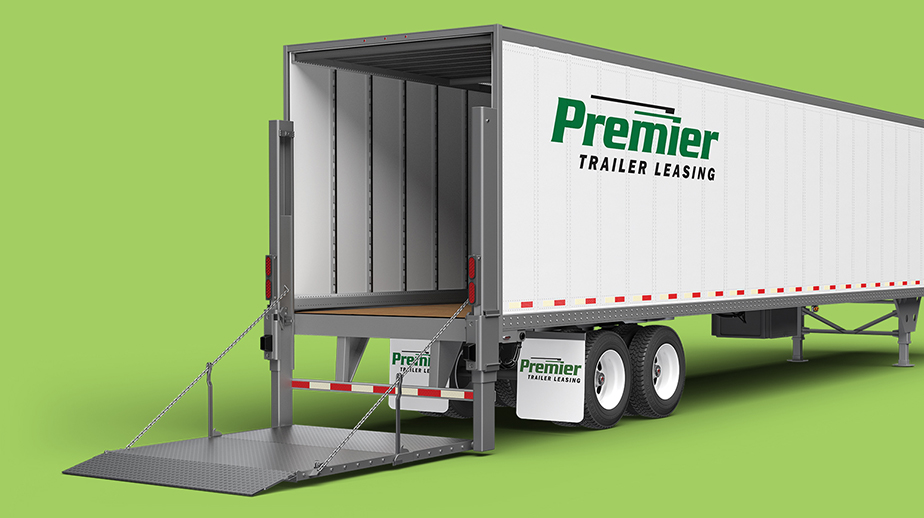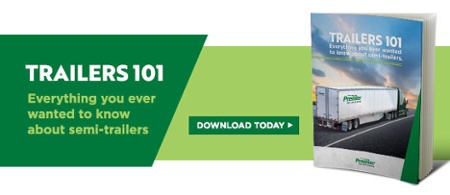By Tim Ifland, VP of Specialty Equipment
It doesn’t matter how well your trailer performs on the road if you can’t get cargo unloaded once you arrive at your destination.
Often forgotten, liftgates are an essential component to an effective cargo transportation operation. They are crucial for loading and unloading cargo when there is no loading dock available and ground deliveries are your only option. Liftgates also help ensure that your employees or contractors can perform their job without injury.
In this post we will cover:
Types of Liftgates
There are various types of liftgates, but there are just a few that are commonly found in our industry:
Column or Rail: These heavy-duty lift gates provide optimal stability for bulky or heavy cargo that needs to be unloaded in a variety of circumstances, offering the highest capacity and often the largest platforms to accommodate a wide variety of loads. Premier Trailer Leasing utilizes this type of liftgate on many of its dry vans and refrigerated trailers.
Tuk-A-Way or Slider: This type of gate folds up under the rear of a trailer. This style of gate is conveniently stored out of the way for loading dock access and can easily accommodate swing door applications.
How to Know When There is an Issue
Frequently the first time an operator realizes there is a problem it is when one of the following symptoms presents itself, which often happens while a driver is out making deliveries.
- Leaks from hoses: Leaks from the hoses of a hydraulic liftgate are an important indication of pending failure and should be addressed as soon as possible.
- Erratic, choppy, or delayed movements: When a liftgate is deployed the process should be smooth and steady. If it is not, that could be an indication of a looming problem.
- Platform not maintaining height: Once deployed, the liftgate should not sink or lose height.
- Not working: The most obvious indication that something is wrong with a liftgate is when the equipment stops working altogether. This situation can be particularly expensive and frustrating, particularly when it happens when cargo needs to be unloaded.
Seven Tips for Success
Avoiding the frustration of your crew arriving at their destination only to be unable to unload cargo requires maintaining your liftgates. Although they may not require as much maintenance as other aspects of your fleet, incorporating a regular program will ensure that they are there when they are needed.
- Choose the right gate for your needs: In addition to choosing between the style of liftgate for your operation, it is equally important to understand how the load will be handled, along with determining options that can assist your drivers in the delivery process. What type/size of pallet jack will be used? What are the dimensions of the pallet(s) that will be utilized? What is the bed/floor height of the trailer? How many deliveries will you make per day that require the liftgate? How many times will the liftgate be cycled up & down? What geographical area will your vehicle(s) be operated? Not sure, reach out to your local Premier Trailer Leasing location for further assistance.
- Lifting Capacity: Exceeding the lifting capacity rating often leads to a quick date with a breakdown that can be very disruptive to your operation and quickly shorten the life expectancy of the gate. Understanding the combined weight of the cargo (including the pallet and the operator) can help guide you to selecting the correct capacity for the heaviest load that your team may encounter.
- Make sure operators are trained on the correct operation of the liftgate: User error is a frequent cause of liftgate issues. Whether it’s forgetting to secure the gate before getting underway or unloading cargo in an unsafe manner, mistakes can be avoided with a comprehensive training program.
- Pre & Post Trip Inspections: Regular visual inspections of the liftgate should be conducted and include a review of its major components, including, but not limited to the columns, platforms, chains, hinges, electrical and hydraulic hoses for any obvious signs of damage, leaks, loose or missing components. While completing this visual inspection you can also do a quick liftgate clean-up to keep it free from debris.
- Auxiliary Battery Charging Solutions: Liftgate batteries can be problematic if you are not providing a source of supplemental power to them during usage or charging them while they are not being utilized. An excellent source is the traditional use of a stinger cord which provides power from the truck’s battery bank. Additionally, the use of a DC/DC converter as Premier Trailer Leasing utilizes on its liftgate fleet provides higher charging voltages that results in well charged batteries that will last longer and have ample power for liftgate operation. We also report the liftgate battery voltage through our trailer tracking system to assist our customers with operating the liftgates more efficiently and avoiding breakdowns.
- Periodic Maintenance: Just like your truck and trailer, the liftgate also requires periodic inspections to ensure safe and trouble-free operation. Liftgate maintenance is often performed based on a defined timeframe or quantity of cycles (up & down) determined by the liftgate manufacturers. Higher cycles require more frequent inspections. Northern geographical areas may require a different hydraulic fluid to accommodate harsh winter conditions. Manufacturer’s recommendations should be followed carefully.
- Keep a record: Just like the rest of your maintenance program, liftgate maintenance should be documented and verified. Documentation can be important to recognizing maintenance trends and help determining when a liftgate may need to be retired or removed from service.
Like many things in the supply chain, minor problems with equipment can quickly escalate to major ones. We hope by utilizing these steps, your fleet can avoid some major issues out on the road.
Contact us for more information - Premier offers 36 locations and more than 50,000 trailers to meet your fleet leasing needs. We'd love to be a resource for you and your team as well!
 Tim Ifland is Vice President Specialty Equipment for Premier Trailer Leasing and an industry veteran. His 35 years of trailer industry experience includes branch operations, sales management, procurement, product SME/sales training, account management and branch equipment services including warranty, quality control, breakdown services, tires, maintenance and safety.
Tim Ifland is Vice President Specialty Equipment for Premier Trailer Leasing and an industry veteran. His 35 years of trailer industry experience includes branch operations, sales management, procurement, product SME/sales training, account management and branch equipment services including warranty, quality control, breakdown services, tires, maintenance and safety.





